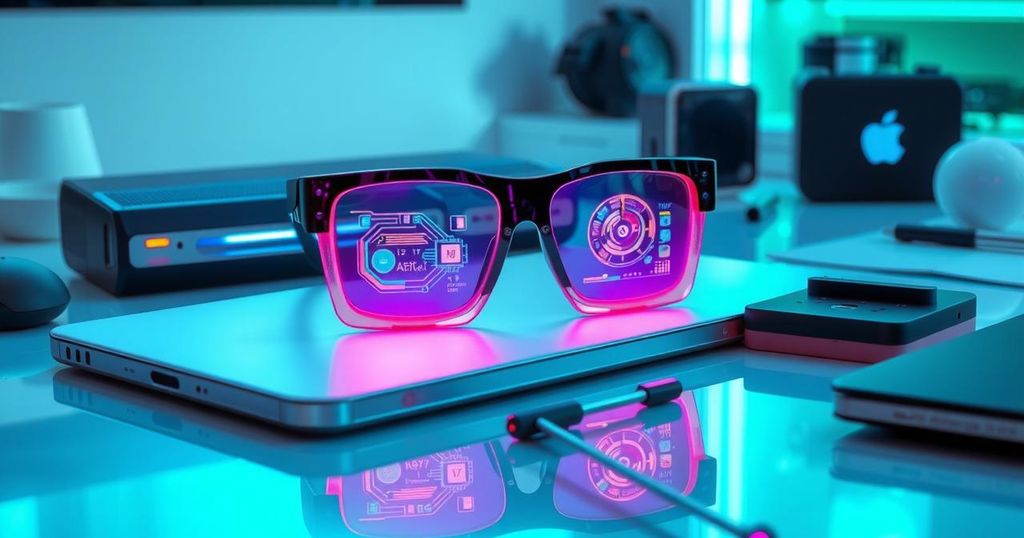Silicon Valley Doubles Down on Smart Glasses as Next Big Tech Trend
Tech giants like Google, Meta, and Snap are pushing for a revival of smart glasses, fueled by advances in artificial intelligence. Snap recently announced AI glasses expected in 2026, while Google and Meta showcase new features that could make smart glasses more appealing. Market research indicates potential growth in the smart glasses market, but privacy concerns and consumer acceptance may pose challenges.
Silicon Valley is buzzing again about smart glasses, with multiple tech giants like Google, Meta, and Snap throwing their weight behind the concept. Remember Google Glass? That ambitious project flopped years back, but now it seems the industry thinks the time might finally be right for smart eyewear. Thanks to advancements in artificial intelligence, these new glasses could actually see, hear, and respond to your inquiries about the world.
Just this week, Snap announced it’s crafting AI-powered eyewear expected to hit the market by 2026. This renewed interest in smart glasses stems from a couple of factors: people are tired of upgrading their smartphones so often, and the tech world is eager to explore new hardware possibilities around AI. “AI is making these devices a lot easier to use,” says Jitesh Ubrani, a research manager at IDC, highlighting how smart glasses could become a game-changer.
In the past, companies like Google, Snap, and Amazon launched various iterations of glasses with capabilities such as photo capture and voice commands. But the early models—Google Glass in particular—had issues like poor battery life and high prices, which made them unappealing. Modern options like Amazon’s Echo Frames and Meta’s Ray-Ban Stories didn’t exactly revolutionize the scene either, as they didn’t offer anything groundbreaking compared to smartphones.
Now, the latest developments have changed the game a bit. Take Google’s prototype glasses for example: I tested them out myself and was amazed. I simply asked the glasses for cocktail recipes based on the liquor bottles I was surveying, and guess what? They delivered! The glasses even remember items you’ve interacted with, answering questions about them later. Meanwhile, Meta’s Ray-Ban glasses have already sold two million pairs since their release, proving there’s a solid market for these high-tech frames.
The outlook is optimistic. ABI Research anticipates that smart glasses will soar from 3.3 million units shipped in 2024 to nearly 13 million by 2026. Meanwhile, IDC projects sales for smart glasses like Meta’s will grow significantly—from 8.8 million in 2025 to almost 14 million the following year. Clearly, market analysts are sensing a shift in consumer interest.
As for Snap’s upcoming models, specifics are still in the shadows, but they promise to help users better understand their surroundings. The company hinted in their blog post, “The tiny smartphone limited our imagination,” suggesting that this new direction aims to elevate how we interact with technology.
Adding to the competition is Apple, who’s reportedly working on its own line of smart glasses set for release next year. They might directly compete with Meta’s offering. Also, Panos Panay from Amazon didn’t shy away from mentioning the potential for Alexa-powered glasses equipped with a camera. Talk about innovation!
And tech like AI assistant apps, such as OpenAI’s ChatGPT, is paving the way for smart glasses by utilizing phone cameras to gather information. Google has been hinting at enhancing camera capabilities in its search apps, underscoring the importance of visual data in how we’ll get information moving forward.
However, there’s a big question mark hovering over these devices: will people actually want them? Privacy isn’t just a minor detail, as Google Glass faced huge backlash partly due to concerns over it recording without others knowing. There’s also the challenge of convincing users that they need yet another device attached to their faces, especially those who don’t wear glasses already.
Generally, these gadgets won’t come cheap—Meta’s Ray-Bans run around $300. This isn’t nearly as pricey as Apple’s hefty $3,500 Vision Pro headset, but with consumer spending on tech slowing down—global smartwatch shipments recently saw their first decline—this raises eyebrows.
Yet tech firms are betting big on smart glasses, hoping to avoid being left behind. “Many in the industry believe the smartphone will eventually be replaced by glasses or something similar,” says Ubrani from IDC. “It’s about ensuring they don’t miss out on that transition when, or if, it happens.”
In summary, the tech landscape is shifting gears, as companies like Google, Meta, and Snap ramp up efforts to revive the idea of smart glasses. With advancements in AI and the potential for growing consumer interest, the market for these devices could see rapid expansion in the coming years. However, privacy concerns and the need for consumer acceptance remain significant hurdles that tech giants must navigate as they introduce this next wave of wearable technology. The question now, can smart glasses finally live up to the hype?
Original Source: www.cnn.com




